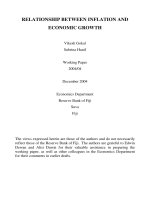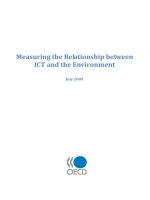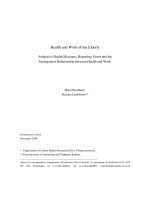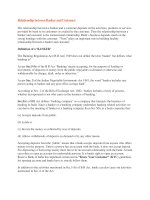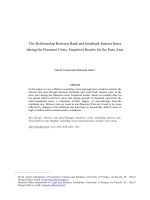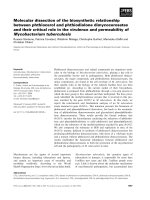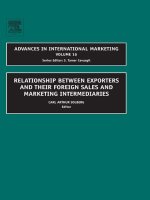RELATIONSHIP BETWEEN EXPORTERS AND THEIR FOREIGN SALES AND MARKETING INTERMEDIARIES
Bạn đang xem bản rút gọn của tài liệu. Xem và tải ngay bản đầy đủ của tài liệu tại đây (2.25 MB, 385 trang )
RELATIONSHIP BETWEEN
EXPORTERS AND THEIR FOREIGN
SALES AND MARKETING
INTERMEDIARIES
i
ADVANCES IN INTERNATIONAL
MARKETING
Series Editor: S. Tamer Cavusgil
Recent volumes:
Volume 5: Industrial Networks
Volume 6: Export Marketing: International Perspectives
Volume 7: Marketing in Asia Pacific and Beyond
Volume 8: Parts I & II
Volume 9: International Marketing and Purchasing
Volume 10: Globalization, the Multinational Firm, and
Emerging Economies
Volume 11: Reassessing the Internationalization of the Firm
Volume 12: New Directions in International Advertising
Research
Volume 13: Study Abroad: Perspectives and Experiences
from Business Schools
Volume 14: Reviving Traditions in Research on International
Market Entry
Volume 15: Research on International Service Marketing:
A State of the Art
ii
ADVANCES IN INTERNATIONAL MARKETING VOLUME 16
RELATIONSHIP
BETWEEN EXPORTERS
AND THEIR FOREIGN
SALES AND MARKETING
INTERMEDIARIES
GUEST EDITED BY
CARL ARTHUR SOLBERG
BI Norwegian School of Management, N orway
Amsterdam – Boston – Heidelberg – London – New York – Oxford
Paris – San Diego – San Francisco – Singapore – Sydney – Tokyo
iii
r 2006 Elsevier Ltd. All rights reserved.
This work is protected under copyright by Elsevier Ltd, and the following terms and conditions apply to its use:
Photocopying
Single photocopies of single chapters may be made for personal use as allowed by national copyright laws. Permission
of the Publisher and payment of a fee is required for all other photocopying, including multiple or systematic copying,
copying for advertising or promotional purposes, resale, and all forms of document delivery. Special rates are
available for educational institutions that wish to make photocopies for non-profit educational classroom use.
Permissions may be sought directly from Elsevier’s Rights Department in Oxford, UK: phone (+44) 1865 843830, fax
(+44) 1865 853333, e-mail: Requests may also be completed on-line via the Elsevier
homepage ( />In the USA, users may clear permissions and make payments through the Copyright Clearance Center, Inc., 222
Rosewood Drive, Danvers, MA 01923, USA; phone: (+1) (978) 7508400, fax: (+1) (978) 7504744, and in the UK
through the Copyright Licensing Agency Rapid Clearance Service (CLARCS), 90 Tottenham Court Road, London
W1P 0LP, UK; phone: (+44) 20 7631 5555; fax: (+44) 20 7631 5500. Other countries may have a local reprographic
rights agency for payments.
Derivative Works
Tables of contents may be reproduced for internal circulation, but permission of the Publisher is required for external
resale or distribution of such material. Permission of the Publisher is required for all other derivative works, including
compilations and translations.
Electronic Storage or Usage
Permission of the Publisher is required to store or use electronically any material contained in this work, including any
chapter or part of a chapter.
Except as outlined above, no part of this work may be reproduced, stored in a retrieval system or transmitted in any
form or by any means, electronic, mechanical, photocopying, recording or otherwise, without prior written permission
of the Publisher.
Address permissions requests to: Elsevier’s Rights Department, at the fax and e-mail addresses noted above.
Notice
No responsibility is assumed by the Publisher for any injury and/or damage to persons or property as a matter of
products liability, negligence or otherwise, or from any use or operation of any methods, products, instructions or
ideas contained in the material herein. Because of rapid advances in the medical sciences, in particular, independent
verification of diagnoses and drug dosages should be made.
First edition 2006
British Library Cataloguing in Publication Data
A catalogue record is available from the British Library.
ISBN-10: 0-7623-1286-6
ISBN-13: 978-0-7623-1286-3
ISSN: 1474-7979 (Series)
∞
The paper used in this publication meets the requirements of ANSI/NISO Z39.48-1992 (Permanence of Paper).
Printed in The Netherlands.
ELSEVIER B.V.
Radarweg 29
P.O. Box 211
1000 AE Amsterdam,
The Netherlands
ELSEVIER Ltd
84 Theobalds Road
London
WC1X 8RR
UK
ELSEVIER Ltd
The Boulevard, Langford
Lane, Kidlington
Oxford OX5 1GB
UK
ELSEVIER Inc.
525 B Street, Suite 1900
San Diego
CA 92101-4495
USA
Working together to grow
libraries in developing countries
www.elsevier.com | www.bookaid.org | www.sabre.org
iv
CONTENTS
LIST OF CONTRIBUTORS ix
LIST OF REVIEWERS xiii
PREFACE
S. Tamer Cavusgil xv
INTRODUCTION
Carl Arthur Solberg xvii
FACTORS AFFECTING SME EXPORT CHANNEL
CHOICE IN FOREIGN MARKETS
Kent Eriksson, Jukka Hohenthal and Jessica Lindbergh 1
BEYOND TRANSACTION COST DETERMINANTS:
AN INTEGRATED FRAMEWORK FOR EXPORT
INTERMEDIARY SELECTION IN EMERGING
ECONOMIES
Xufei Ma 23
LEGAL VERSUS RELATIONAL ORDERING IN
CHANNEL GOVERNANCE: THE CASE OF THE
MANUFACTURER AND ITS FOREIGN
DISTRIBUTOR
Seyda Deligonul and S. Tamer Cavusgil 49
RELATIONAL DRIVERS, CONTROLS AND
RELATIONSHIP QUALITY IN EXPORTER–FOREIGN
MIDDLEMAN RELATIONS
Carl Arthur Solberg 81
v
DELIVERING VALUE: MARKET ORIENTATION AND
DISTRIBUTOR SELECTION IN EXPORT MARKETS
Andre Beaujanot Q., Larry Lockshin and
Pascale Quester
107
THE EFFECT OF INFORMATION COLLECTION
BEHAVIOUR ON MARKET PERFORMANCE: THE
ROLE OF PARTNER RELATIONSHIPS
Geir Gripsrud, Carl Arthur Solberg and Arne M. Ulvnes 135
UTILIZING RELATIONAL GOVERNANCE IN
EXPORT RELATIONSHIPS: LEVERAGING
LEARNING AND IMPROVING FLEXIBILITY AND
SATISFACTION
Anthony S. Roath and Rudolf R. Sinkovics 157
MANAGING CHANNEL RELATIONS IN CHINA: AN
EXPLORATORY STUDY
Paul Matthyssens and Wouter Faes 187
BUYER TOLERANCE OF CONFLICT IN CROSS-
NATIONAL BUSINESS RELATIONSHIPS: AN
EMPIRICAL STUDY
Inger Beate Pettersen and Aksel I. Rokkan 213
IDENTIFYING DIFFERENCES IN FOREIGN
CUSTOMERS’ RELATIONAL BEHAVIOR: AN
EXPLORATORY STUDY USING
MULTIDIMENSIONAL SCALING
Bjo
¨
rn Sven Ivens 245
AN EXPLORATORY EXAMINATION OF THE
FACTORS INFLUENCING DISTRIBUTOR SELF-
PERCEIVED POWER IN CHANNEL RELATIONSHIPS:
A SEVEN-COUNTRY STUDY
Goksel Yalcinkaya and David A. Griffith 267
CONTENTSvi
TIMING AND SEQUENCING OF STRATEGIC
ACTIONS IN INTERNATIONALIZATION PROCESSES
INVOLVING INTERMEDIARIES: A NETWORK
PERSPECTIVE
Per Andersson and Lars-Gunnar Mattsson 287
THE TERMINATION DILEMMA OF FOREIGN
INTERMEDIARIES: PERFORMANCE, ANTI-
SHIRKING MEASURES AND HOLD-UP
SAFEGUARDS
Bent Petersen, Torben Pedersen and
Gabriel R.G. Benito
317
EXPORTER GOVERNANCE OF INTEGRATED AND
INDEPENDENT MARKETING CHANNEL MEMBERS
IN INTERNATIONAL MARKETS: MODERATING
EFFECTS OF STAGE OF RELATIONSHIPS AND
OPERATION MODE
Carl Arthur Solberg 341
Contents vii
This page intentionally left blank
viii
LIST OF CONTRIBUTORS
Per Andersson Stockholm School of Economics, Stockholm,
Sweden
Andre Beaujanot Q. School of Marketing, University of South
Australia, Adelaide, Australia
Gabriel R.G. Benito Department of Strategy and Logistics, BI
Norwegian School of Management, Oslo,
Norway and Department of International
Economics and Management, Copenhagen
Business School, Copenhagen, Denmark
S. Tamer Cavusgil The Eli Broad Graduate School of
Management, Michigan State University, MI,
USA
Seyda Deligonul Bittner School of Business, St. John Fisher
College, USA
Kent Eriksson CEFIN, the Centre for Banking and Finance,
School of Architecture and the Built
Environment, KTH – The Royal Institute of
Technology, Stockholm, Sweden
Wouter Faes Hasselt University (former Limburg University
Center), Belgium
David A. Griffith The Eli Broad Graduate School of
Management, Michigan State University, MI,
USA
Geir Gripsrud Department of Marketing, BI Norwegian
School of Management, Sandvika, Norway
ix
Jukka Hohenthal Department of Business Studies, Uppsala
University, Uppsala, Sweden
Bjo
¨
rn Sven Ivens Friedrich-Alexander-University, Erlangen-
Nuremberg, Germany
Jessica Lindbergh CEFIN, the Centre for Banking and Finance,
School of Architecture and the Built
Environment, KTH – The Royal Institute of
Technology, Stockholm, Sweden
Larry Lockshin School of Marketing, University of South
Australia, Australia
Xufei Ma Department of Business Policy, NUS Business
School, National University of Singapore,
Singapore
Paul Matthyssens Department of Management, Antwerp
University, Belgium and Department of
Marketing Management, Erasmus University,
Rotterdam, The Netherlands
Lars-Gunnar
Mattsson
Stockholm School of Economics, Stockholm,
Sweden
Torben Pedersen Department of International Economics and
Management, Copenhagen Business School,
Frederiksberg, Denmark
Bent Petersen Department of International Economics and
Management, Copenhagen Business School,
Frederiksberg, Denmark
Inger Beate
Pettersen
Institute for Research in Economics and
Business Administration, Bergen, Norway
Pascale Quester School of Commerce, The University of
Adelaide, Australia
Anthony S. Roath The University of Oklahoma, OK,
USA
Aksel I. Rokkan Bodø Graduate School of Business, Bodø
Regional University, Norway
LIST OF CONTRIBUTORSx
Rudolf R. Sinkovics The University of Manchester, Manchester
Business School, UK
Carl Arthur Solberg Department of Marketing, BI Norwegian
School of Management, Sandvika, Norway
Arne M. Ulvnes Department of Marketing, BI Norwegian
School of Management, Sandvika, Norway
Goksel Yalcinkaya The Eli Broad Graduate School of
Management, Michigan State University, MI,
USA
List of Contributors xi
This page intentionally left blank
xii
LIST OF REVIEWERS
Gabriel R.G. Benito BI Norwegian School of Management,
Norway
Harald Biong BI Norwegian School of Management,
Norway
S. Tamer Cavusgil Michigan State University, USA
Seyda Deligonul St. John Fisher College, USA
Francois Durrieu Bordeaux School of Management, France
David A. Griffith Michigan State University, USA
Kjell Gro
¨
nhaug Norwegian School of Economics and Business
Administration, Norway
Ha
˚
kan Ha
˚
kanson BI Norwegian School of Management
Norway
Siv Marina Karlsen Oslo University College, Norway
Tibor Mandjak Bordeaux School of Management, France
Lars Gunnar
Mattson
Stockholm School of Economics, Sweden
Tore Mysen Oslo School of Management, Norway
Erik Nes BI Norwegian School of Management,
Norway
Bent Petersen Copenhagen Business School, Denmark
xiii
Ragnhild Silkoset BI Norwegian School of Management,
Norway
Carl Arthur Solberg BI Norwegian School of Management,
Norway
Barbara Sto
¨
ttinger Wirtschaftsuniversita
¨
t Wien, Austria
Chris Styles University of Sydney, Australia
Lawrence Welch Mt. Eliza Business School, Australia
J. Chris White Michigan State University, USA
LIST OF REVIEWERSxiv
PREFACE
This special volume of Advances in International Marketing is focused on
international marketing channels. Specifically, it explores substantive issues
relating to the role of foreign intermediaries in export channels. Independent
distributors or agents are commonly engaged by exporting manufacturers,
yet academic research in this area is very limited. We are delighted to feature
the latest research findings and insights on this topic contributed by
authoritative colleagues from around the world. It is guest edited by Carl
Author Solberg of BI Norwegian School of Management.
The idea for devoting a separate volume on foreign intermediaries
originated from Professor Solberg. We issued a call for papers, which then
attracted a variety of submissions of high quality. We owe gratitude to him
for screening and evaluating these submissions, and for preparing the final
set of chapters. We are also indebted to many colleagues who assisted in the
review process. The resulting selections draw from a variety of perspectives
and offer rich insights on foreign intermediaries.
Our thanks go to Professor Solberg for his efforts in creating this volume.
At Michigan State University, I would like to recognize the professional
assistance of Ms. Kathy Waldie, Editorial Assistant for the Advances in
International Marketing series. Kathy carries the responsibility of corre-
sponding with the authors, guest editors, as well as the staff of Elsevier
Science at various phases of the publication process. Finally, we express our
appreciation to Ms. Hannah Collett and the other staff at JAI/Elsevier
Science who saw the volume through the production process.
S. Tamer Cavusgil
Series Editor
xv
This page intentionally left blank
xvi
INTRODUCTION
It has been said that cho ice of entry mode – or more broadly, operation
mode – is one of the most important decisions made by international mar-
keters (
Young et al., 1989). This decision determines many other variables of
the international marketing effort such as monitoring and control, use of
resources and financial risk. Much of the focus of the international mar-
keting literature well into the 1990s was directed primarily toward the entry
and operation mode decision. The main purpose of this line of research was
to explain integration of firms’ international operations. From an interna-
tional marketing viewpoint, the decision to set up a sales subsidiary instead
of using independent middlemen such as agents or distributors was critical.
Two theoretical approaches dominated the discussion: Transaction Cost
Economics (TCE) and the Internationalization Process model (IP). The ba-
sic premise of TCE is that (in our context) a foreign middleman behaves
opportunistically. The costs of controlling such opportunistic behavior are
higher under conditions of high-asset specificity, uncertainty and volatility,
leading the firm to integrate its market operations. IP is based on the theory
of the growth of the firm (
Penrose, 1959) and explains entry mode by the
accumulation of experience over the years. Whereas TCE is concerned with
structure, IP studies the internal processes of the firm that lead to a build up
of resources allowing bolder steps in its inter national ventures.
The issue of operation mode – however important it is – doe s not really
explain why certain ventures are doing better than others. In fact a study
among Norwegian exporters found no significant differences between op-
eration modes concerning export performance (
Solberg & Nes, 2002).
Whatever operation mode, the international marketer needs to relate to
people in organizations, be it its own employees in a subsidiary or an in-
dependent middleman – licensee, distributor, agent or other. One could
therefore claim that the success of the intern ational marketing effort hinges
more on these relational factors than on the operation mode itself. The
xvii
majority of the articles of this volume of AIM discuss different aspects of
these relations.
In contrast to the IP model that explore s the internal processes of the firm,
the study of exporter–middleman relations treats bilateral processes between
trading partners, and therefore extends the field of study beyond the ex-
porting firm. This field of study has only received attention the last 10 years
or so. Indeed, research emanating from IMP
1
– scholars such as Ford and
Rosson did delve into different aspects of these relationships in the early
1980s (
Ford & Rosson, 1982), but a more thorough and rigid analysis of
exporter–middleman relations gained impetus only in the late 1990s with
contributions from writers such as
Aulakh, Kotabe, and Sahay (1996), Celly
and Frazier (1996)
, Bello and Gilliland (1997), de Mortanges and Vossen
(1999)
. Since then several contributions have appeared (see for instance
Bello, Chelaru, & Li Zhang, 2003; Zhang, Tamer Cavusgil, & Roath, 2003).
The main part of this volume of AIM could be seen as a continuation of
this stream of literature, elaborating on different aspects of it, such as cul-
tural and dynamic aspects of these relations, or delving more deeply into
details concerning information capture and learning in international busi-
ness relationships. Deligounul and Cavusgil in this volume claim that find-
ings and interpretations in empirical studies of channel governance are
rather disparate, blaming lack of agreement on its characteristics and un-
derlying mechanisms. In particular, they assert that governance is conceived
as process or structure, but each approach is incomplete. A focus on process
overemphasizes control aspects and fails to explain informal governance
arrangements, whereas a structural view ignores behavioral norms and
sanctions. I believe that this sums up pretty neatly the issues at stake in
exporter–intermediary relations.
This volume is more concerned with the phenomena under study than
with casting light on one particular theoretical perspective. The contribu-
tions represented here are therefore drawing on a number of different the-
oretical streams: agency theory, transaction cost economics, network theory,
economic sociology, resource base theory and its applied ‘‘offspring’’, In-
ternationalisation Process school of thought. I should also mention that the
contributions to this volume come from researchers from universities in
nine different countries: Aust ralia, Belgium, Denmark, Germany, Norway,
Singapore, Sweden, United Kingdom and the USA, representing both well-
established and young academicians. This I believe is a manifest ind ication
of the importance of this field of research. In fact, it is my conviction that
success in exporting goes primarily through well functioning relations with
the exporter’s trading partner(s) in its target market(s). It is therefore of
CARL ARTHUR SOLBERGxviii
great interest to try and understand the underlying mechanisms of these
relations.
The volume is divided into four distinct parts, dealing with different aspects
of exporter–intermediary relations: (1) Channel choice, partner selection and
governance in international markets; (2) information and learning aspects of
exporter–intermediary relations; (3) cultural aspects of exporter–intermediary
relations; and (4) dynamics of exporter–intermediary relations. The remain-
der of this introduction will give a brief review of each contribution.
CHANNEL CHOICE, PARTNER SELECTION AND
GOVERNANCE IN INTERNATIONAL MARKETS
This part contains four papers. Even though this volume of AIM primarily
concerns exporter–intermediary relations, the first two contributions deal
with channel choice and partner selection. The first chapter by Kent Eriksson,
Jukka Hohenthal and Jessica Lindbergh, ‘‘SME export channel choice in
international markets’’, tests some of the fundamental factors proposed by
the IP model explaining choice of entry mode (accumulation of know-
ledge of foreign markets determining foreign operation modes). Later devel-
opments of the model claim that experience and knowledge of local business
relationships are also essential elements of the IP model. Whereas the IP
model has been found to hold well for incremental resource commitments, it
has – in contrast to transaction-cost theories – produced mixed results con-
cerning its ability to explain operation modes. The authors present findings
from research in 494 firms from Sweden, Denmark and New Zealand: factors
included in the initial explanation of the IP model explain choice of channel,
but later developments of the model do not. Implications are that the foreign
market knowledge is, and that more incremental experiential knowledge ac-
cumulation is not relevant for export channel choice as regards integrated or
non-integrated channel. The results show that for Small and Medium Sized
Businesses (SMEs), expected market growth lead to use of integrated chan-
nels. Integrated channels make it possible to reap more of the profits from a
growing market and to learn faster about what is going on in the market.
They also found that use of integrated channels is correlated with cultural
distance, contradicting the findings of
Johanson and Vahlne (1977) and Ko-
gut and Singh (1988)
. The IP model therefore offers a rather weak expla-
nation of choice of integrated channel.
The second chapter, ‘‘Beyond transaction cost determinants: an integrat-
ed framework for export intermediary selection in emerging economies’’, is
Introduction xix
written by Xufei Ma. He makes the pertinent remark that entry mode has
been studied from a range of different theoretical perspectives, whereas
partner selection has been given little attention. Discussing different theo-
retical approaches to partner selection – TCE, resource-based view, insti-
tutional theory and network perspective – Xufei Ma proposes an integrated
framework to investigate export intermediary selection in emerging econ-
omies. His choice of setting is pertinent in that emerging economies over-
state some of the variables that go into these different strings of theory:
uncertainty, volatility, institutional structures and access to key persons.
The chapter highlights the unique resources associated with the intermedi-
aries’ institutional traits, organizational forms and micro–macro links in
emerging economie s.
In their paper, ‘‘Legal versus relational ordering in channel governance:
the case of the manufacturer and its foreign distributor’’, Seyda Deligounul
and S. Tamer Cavusgil present governance as a manifestation of needs for
safeguarding trust, adaptation, control and ability to predict. In their
view, this explains a wide spectrum of governance issues, ranging from self-
regulation to formal structural arrangements. The empirical context is the
typical international distribution channel, in which the manufacturer part-
ners with foreign distributors. Their results suggest that, when contemplat-
ing governance in a long-term relationship, an export manufacturer and its
foreign distributor are confronted with a tradeoff between the costs of
crafting a more complete agreement and the inefficiencies associated with
less exhaustive arrangements. Also, the investigation suggests the role of
organizational trust in a cross-border context to be redefined since it is at
odds with what is touted in the literature for the domestic case. The study
reveals that trust is not an alternative to formal control mechanisms as
assumed by some. It can only serve to fill the gaps left by imperfect controls
with a certain leap of faith.
Carl Arthur Solberg extends recent research in international exporter–
intermediary relations in his contribution, ‘‘Relational drivers, controls and
relational quality in expo rter–foreign middl eman relations’’, by introducing
relationship quality as a key-mediating variable in explaining export per-
formance. He also broadens the repertoire of governance antecedents in
international business relations to include power relations and social bonds
between the relationship partners. He furthermore introduces a distinction
between antecedents that are ‘‘easily’’ manipulated in the short term by the
trading partners (social interaction, investments in relations, information
exchange and flexibility) and more structural factors that are more difficult
to change in the short term such as power relations, cultural distance and
CARL ARTHUR SOLBERGxx
resource availability. In a study of a cross section of Norwegian exporters he
finds that relationship quality is negatively affected by process control and
positively by clan control, suggesting that centrally controlled and moni-
tored marketing programs need to be backed by flexibility and social re-
lations. Moreover, variance in export performance is to a large extent
explained (68%) by relationship quality.
INFORMATION AND LEARNING ASPECTS OF
EXPORTER–INTERMEDIARY RELATIONS
This part consists of three contributions dealing with different aspects of
market information and learning. The first ch apter, ‘‘Delivering value:
market orientation and distributor selection in export markets’’, is written
by Andre Beaujanot, Larry Lockshin and Pascale Quester. They examine
the proposition that in export markets, market-oriented firms are better able
to capitalize on their market orientati on if they do business with customers
(overseas distributors) having business characteristics that are in accordance
with the firm’s market orientation. Their investigation carried out among 77
Australian wine exporters, proposes the exporter’s market orientation has a
direct effect on the exporter’s required international distributor characte-
ristics. These characteristics are seen as a filter, as the exporter may use them
to select the most appropriate international clients. They receive support for
the hypothesis that exporters who are market oriented and select interna-
tional distributors having business characteristics that are linked to their
market orientation perform better as they can create and deliver superior
customer value.
Geir Gripsrud, Carl Arthur Solberg and Arne Morten Ulvnes investigate
the role of partner relationships in market information collection behavior
from foreign markets. They develop and test a conceptual model of the
association between information collection from two different sources
(the intermediary and ‘‘other’’) and performance in export relationships.
The behavior of exporters in collecting information is posited to be influ-
enced by the exporter’s trust in its foreign chann el partner, and the asso-
ciation between information collection and performance is argued to
be moderated by the length of expe rience with the trading partner . Data
from 285 Norwegian exporters in the ‘‘bio’’-industry (food and wood) is
presented. The findings suggest that trust correlates positively with infor-
mation collection from the representative and negatively with information
Introduction xxi
collection from other sources. However, information from both these
sources contributes positively to market performance. They finally conclude
that the longer the relationship has lasted, the more pos itive effect infor-
mation from other sources will have.
Anthony Roath and Rudolf Sinkovics examine two distinct relational
governance mechanisms in their contribution, ‘‘Utilizing relational govern-
ance in export relationships: leveraging learning and improving flexibility
and satisfaction’’. They analyze 141 US exporting manufacturers to explore
whether the manufacturer’s utilization of relationship governance helps to
leverage learning, establish flexibility in dealing with distributors from dis-
parate environments, and eventually contribute to satisfactory relationship
outcomes. The empirical analysis provides support for the perspective of
relational governance as a hybrid mechanism that both facilitates and aug-
ments learning between cross-border organizations. Flexibility is enhanced
and relationship outcomes are more satisfactory. The results suggest a
direction for appropriate management of internati onal distributors. The
fundamental changes in the technological, social, political and economic
environment have shaped the trend of relationship marketing to go beyond
the evolutionary stages of the idea to eventually evo lve into a discipline.
Initially, common conceptualization of relationship marketing involved
distinguishing between the ‘internal’ organizational perspective and the ‘ex-
ternal’ (i.e., customer) perspective.
CULTURAL ASPECTS OF EXPORTER–
INTERMEDIARY RELATIONS
Culture is a particularly complex construct and is difficult to study
(
Shenkar, 2002). However, its obvious importance in cross-border business
relationships makes it a ‘‘must’’ in a volume like the present one. This part
consists of four contributions investigating different aspects of cultural fac-
tors on cross-border exporter–intermediary relations and using different
methodological approaches to the subject. In the first article, ‘‘Managing
channel relations in China: an exploratory study’’, Paul Matthyssens and
Wouter Faes study channel leadership experiences by a number of Western
principals in China. They introduce the reader to different levels of rela-
tionships in Chinese business culture: renquin (human feelings), bao (give
and take) and the more commonly recognized guangxi (importance of
relationships and networks). Based on depth interviews they report the
CARL ARTHUR SOLBERGxxii
experiences of 14 companies suggesting the importance of a ‘dual approach’
in building trustful relations. In this environment, managing channel rela-
tions require a balanci ng act of positive actions and monitoring, joint
decision making and guidance. The basics of channel theory remain valid in
China, but the need for building deep trust (ren quin) in the relation with
Chinese intermediaries implies a holistic approach rather than – perhaps
more common in Western economies – an analytic approach only.
Inger Beate Pettersen and Aksel Rokkan suggest in their article, ‘‘Buyer
tolerance of conflict in cross national business relationships: an empirical
study’’, that boundary spanning personnel are required to invest heavily in
effort and adaptations in order to surmount cultur al divergences. This
chapter investigates how cultural knowledge and cultural adaptation efforts
enhance the intermediaries’ capacity to communicate across cultures. More-
over, the study examines how intermediaries’ cultural knowledge, cultural
adaptation and communication affect buyer tolerance of conflict in cross-
national dyads. The authors conduct a survey of cross-national buyer–
supplier relationship within the French seafood industry. The findings not
only corroborate the conventional wisdom that cultural knowledge and
cultural adaptation enhance the capacity to communicate across cultures,
but also that high levels of intermediary communication are found to in-
crease buyers’ tolerance of conflict. Moreover, the interaction effect between
cultural knowledge and cultural adaptation is shown to enhance buyer
tolerance of conflict.
The extant literature suggests important differences between domestic and
foreign business relationships, but ‘‘foreign relationships’’ is a broad cat-
egory, and little is known about specific national relational behaviors. In the
article, ‘‘Identifying differences in foreign customers’ buying behavior: a
study using multidimensional scaling’’, Bjo
¨
rn Sven Ivens uses multidimen-
sional scaling in order to analyze 121 business relationships between
German firms and their trading partners in their home market and nine
other countries: Sweden, Poland, Italy, France, USA, Brazil, South Africa,
Japan and the People’s Republic of China. Investigating export managers’
perceptions of their foreign customers’ relational behavior he suggests that
national business behaviors can be classified along two dimensions: ‘‘co-
operation’’ and ‘‘social vs. efficiency orientation’’. Eight factors were iden-
tified and associated with the respective countries: Whereas USA and North
European countries are characterized by ‘‘time is money’’ and ‘‘improvi-
sation’’, Latin countries are featured by ‘‘frequent contacts’’ and ‘‘individual
decision-taking’’. China is distinguished by three factors, ‘‘self assertion’’,
‘‘importance of context’’ and ‘‘private contacts’’ (corroborating some of the
Introduction xxiii
findings by Matthyssens and Faes in Chapter 8), and finally Japan with one
factor, ‘‘formalization’’.
The final chapter in part three investigates how self-perceived power in
different countries is affected by culture. Research has found asset specificity,
type of market and uncertainty to be important influencers of channel power.
While these variables have been found to affect power in international chan-
nel relationships they have been examined in isolation and have excluded the
influence of culture. Goksel Yalsinkaya and David A. Griffith endeavor in
their article, ‘‘Factors influencing distributor self-perceived power in channel
relationships: a seven country study’’ to fill this gap. Their study of rela-
tionships between 228 US firms and their distributors in seven countries (US,
Canada, Chile, Great Britain, Mexico, the Philippines and Singapore) – using
multiple regression and stepwise regression analysis – identify culture as a
main antecedent of self-perceived power along with uncertainty and asset
specificity (type of market does not affect self-perceived power in this study).
Including culture increases explained variance from 13% to 24%.
DYNAMICS OF EXPORTER–INTERMEDIARY
RELATIONS
Building relations between trading partners takes time, and this aspect of
exporter–intermediary relationships has been given little attention in the
literature. In this part we investigate different aspects of the dynamism that
lies in any relationship. Per Anders son and Lars-Gunnar Mattsson explore
the importance of when an action is carried out during a firm’s interna-
tionalization process in their article, ‘‘Timing and sequencing of strategic
actions in internationalization processes involving intermediaries – a net-
work perspective’’. This is important to study because opportunities and
restrictions change over time due to concurrent internationalization of other
firms in its market context. The analytical problems and purpose of the
paper are connected to this basic assumption. They discuss the timing issue
in general and with reference to internationalization in a markets-as-net-
works perspective. A case of internationalization of an intermediary in the
electronic components industry is used as an example of interdependent
sequences in internationalization processes affecting an individual firm.
A conceptual framework for analysis of timing is developed, and major
aspects are identified in a number of propositions and some issues for fur-
ther research is suggested.
CARL ARTHUR SOLBERGxxiv

